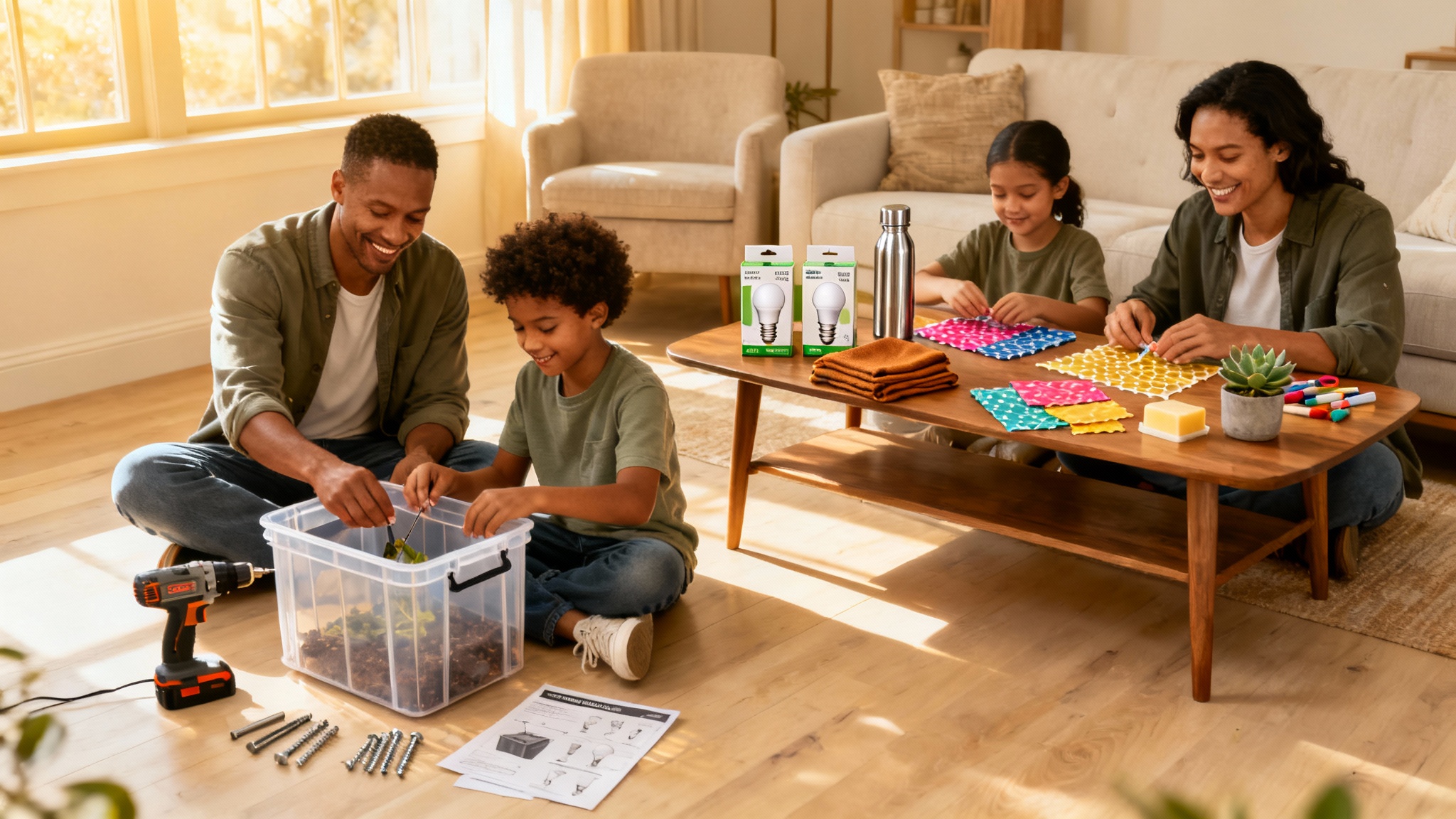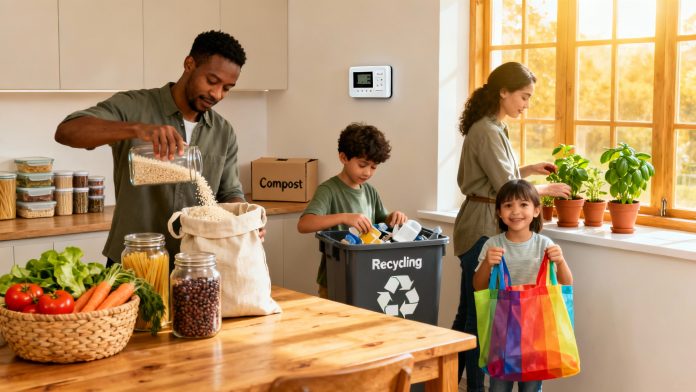Introduction: Why “Green” Can Also Mean “Affordable”
Sustainable living means using resources wisely so our families and our planet stay healthy. It is not about buying expensive gadgets or redesigning your whole house. It is about simple habits that lower waste, save energy, and cut costs week after week.
Many people think “eco-friendly” always costs more. In reality, most budget-friendly, sustainable living choices are small changes: switching to LED bulbs, planning meals, using reusable containers, and buying second-hand. These actions make your home safer, your bills lower, and your routines easier.
Section 1: Sustainable Living-Why It Matters for Families
Health, money, and community benefits
When you reduce harsh chemicals, open windows for fresh air, and switch to DIY natural cleaners, you support better indoor air quality. That helps kids with sensitive skin or allergies. When you use less energy and water, you pay less for utilities.
Those savings can help with school supplies, sports fees, or a family day out. Choosing local produce and seasonal foods also supports nearby farmers and reduces the carbon footprint tied to long-distance shipping. One family’s choices may feel small, but when your kids learn these habits early, the impact grows every year.
The big picture, made simple.
Every home uses electricity, water, and products in daily life. By making tiny, steady improvements – like unplugging idle chargers or fixing a draft – you waste less. Over a month, those minutes and pennies add up. Over a year, they can become real money and real protection for the environment. Think of it like a team sport: each family member plays a role, and together you win.
Section 2: Budgeting for a Greener Home
Track, set goals, and celebrate
First, take a look at your most significant expenses at home: energy, groceries, and transport. Look at one month of bills and receipts. Where can you reduce 10% without losing comfort?
In the next four weeks, involve the family in establishing one clear goal or aim for the household, such as “cut down on food waste” or “add on two trips without cars. Place this goal on your refrigerator door or somewhere obvious so that everyone sees it and looks at it often. When you hit the goal, mark the moment in a low-cost way: picnic, library movie night, or family bike ride.
Smarter purchasing decisions
Before buying, ask: Do we need this now? Do we already own something that works? Many families save by choosing second-hand for fast-growing kids-think coats, books, and sports gear. Buy in bulk for items you use often, like rice, beans, or soap refills. Choose products with minimal packaging to reduce waste. A simple 24-hour pause before non-essential purchases prevents impulse buys and supports your family budget.

Section 3: Energy Efficiency and Home Habits
Easy switches that pay off
Swap out your most-used bulbs for LED lights. They last longer and use far less energy. Use a bright power board for your TV, gaming consoles, and phone chargers to stop “standby” power use. Try to keep the curtains open during the day to take advantage of natural light and switch off the lights whenever you exit a room.
In the colder months, use weather stripping to fill in small gaps around windows and doors. In warmer months, use fans to help your AC work less. By making such simple choices, you reduce your bill without sacrificing comfort.
Laundry and kitchen routines
Do your laundry in cold water, as new-age detergents clean well without the need for hot water. Whenever you can, dry your clothing outside, and only operate the dryer with full loads.
The easiest way to cook smarter in the kitchen is to put a lid on your boiling pots, use the right-sized pans on a burner, and turn your oven off a few minutes early so that you can burn less gas and use up the heat that was already generated. These small steps reduce energy use every single day.
Section 4: The 3 R’s- Reduce, Reuse, Recycle
Reduce: buy and waste less.
Plan four to five dinners for the week and make a simple shopping list. Use what you already have-build one “eat-the-fridge” night to finish leftovers. Choose bulk items you always use, and skip freebies you do not need. Less stuff means less clutter and less trash.
Reuse: give items a second life
Keep a small box of clean glass jars for leftovers, snacks, and crafts. Swap paper towels for microfiber cloths and cloth napkins. Turn cardboard boxes into toy bins or art supply caddies. When you reuse, you save money and teach kids creative problem-solving.
Recycle: do it right.
Set up a simple recycling station with clear labels and pictures. Rinse containers so they do not contaminate the bin. Learn your local rules-every city accepts different items. Recycling is not a cure-all, but when you reduce and reuse first, proper recycling helps a lot.
Section 5: Affordable, Sustainable Food Choices
Plan meals, protect your budget.
Pick a few “family hits” you can rotate: a pasta night, a bean-and-rice bowl, a roast-once-eat-twice meal. Double a recipe and freeze half. This reduces last-minute takeout, which often costs more and creates extra packaging waste. Keep a “use-first” bin in the fridge for items that need to be eaten soon.
Shop smart: local, seasonal, simple.
Buying seasonal produce is often cheaper and fresher. Choose minimal packaging when you can-use loose apples instead of plastic bags, and opt for bulk oats instead of single-serve packets. Compare unit prices on shelf labels. Simple foods like beans, eggs, and oats are budget-friendly and nutritious.
Grow a little
Kids can get thrilled about munching on something if they helped grow it. This can be achieved with window sill herbs, a pot of tomatoes on the balcony, or a plot at the community garden. Gardening teaches patience, science, and respect for food.
Section 6: Green Transportation for Busy Families
Small changes, significant savings
If you’re going somewhere close, walk or bike. Examples include the library or weekend sports practice. If you have to drive, combine all your errands into one trip instead of many.
Try to carpool for after-school activities to lessen fuel costs and traffic. Please make sure that you inflate your tyres properly and remove roof racks when not in use. These measures can help to enhance the longevity of gas and lessen your carbon footprint.
Section 7: Raising Eco-Conscious Kids on a Budget
Make it hands-on and fun.
Kids learn best by doing. Start a simple compost for fruit and vegetable scraps. Turn recycling into a sorted game with timers, stickers, and more! Take nature walks and bring a bag to collect litter.
Talk about local birds, trees, and insects. Encourage the kids to choose an eco-goal they can stick to for the month, like taking a shorter shower or packing a reusable water bottle every day. Praise effort, not perfection.
Section 8: Thrift, Swap, and Share-Sustainable Consumption
Spend less, get more.
Visit thrift stores and consignment shops for clothes, books, and home items. Kids grow fast, so second-hand saves money and reduces waste. Join or organize toy and book swaps at school or in your neighborhood. Before buying a tool, party item, or sports gear you will use once, ask to borrow from a friend or a local “library of things.” Sharing builds community and keeps closets clear.
Section 9: DIY Cleaners and Household Solutions
Easy recipes that work
Most DIY natural cleaners use simple, low-cost items. Try an all-purpose spray: 1 cup vinegar + 1 cup water + a slight squeeze of dish soap. (Do not use vinegar on natural stone.) For tubs and sinks, mix three parts baking soda with 1 part water to make a gentle scrub. For glass, use 1 cup of water + 1 cup of vinegar. These cleaners cut costs, reduce strong smells, and limit exposure to harsh chemicals.
Health and environment win.
Fewer chemicals can mean fewer headaches and less irritation for sensitive skin. Reusing spray bottles reduces plastic waste. Over time, you will notice your cleaning shelf is simpler and cheaper.
Section 10: Building Community and Support Networks
Learn and grow together.
Look for free resources: library maker spaces, weekend sustainability workshops, and community gardens. Join “Buy Nothing” groups to give and receive items locally. Consider a school green team to run clothing swaps, plant trees, or lead recycling days. When families help each other, everyone saves money and learns faster.
Section 11: Overcoming Common Hurdles
Time
Batch tasks. Wash full loads. Chop veggies once for two meals. Keep a basic weekly plan so you do not make 10 small trips.
Convenience
Place reusable bags by the door and reusable bottles on the counter. Keep a small kit in the car with a tote, cutlery, and a container for leftovers.
Family buy-in
Let each person pick one green habit and own it. Track progress on a simple chart. Celebrate with low-cost rewards: park day, movie at home, or a favorite homemade dessert.
Quick-Start Family Checklist
-
Swap five bulbs for LED
-
Set a thermostat schedule
-
Plan 4 dinners + 1 “eat-the-fridge” night
-
Label a recycling station
-
Pack reusable bottles and lunch kits
-
Choose one car-free trip this week
-
Mix one DIY cleaner
-
Visit a thrift store or local swap
-
Plant herbs on a windowsill
-
Join a community garden or workshop
Conclusion: Start Small, Save Big, Grow Together
Sustainable living is not a race or a test. It’s a set of simple habits your family can build one at a time. When you switch to LED bulbs, plan meals, use reusable containers, and shop second-hand, you cut waste and lower bills, without losing comfort. These budget-friendly choices protect your family’s health, reduce your carbon footprint, and make daily life easier.
The real secret is progress over perfection. Pick two actions this week, say, set a thermostat schedule and plan four dinners with one “eat-the-fridge” night. Next week, add a DIY cleaner or a car-free trip. Let kids help with recycling, gardening, or turning off lights. Small wins add up, and every family member can play a part.
You don’t have to do it alone. Lean on community gardens, library workshops, swap groups, and neighbors who share tools or kids’ gear. Together, families save more money, learn faster, and keep more items out of the bin. The result is a home that feels calmer, cleaner, and kinder to the planet.
Your next three steps:
-
Choose two habits from the checklist and post them on the fridge.
-
Set a four-week goal (energy, food waste, or transport) and track it as a family.
-
Celebrate with a low-cost reward-park picnic, library movie night, or a bike ride.
Please keep it simple. Keep it steady. With a few eco-friendly family habits, your home can be both greener and more affordable today, next month, and all year long.

